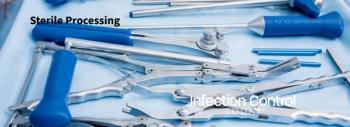
Infection Intel: Revolutionizing Ultrasound Probe Disinfection With Germitec's Chronos
Learn how Germitec’s Chronos uses patented UV-C technology for high-level disinfection of ultrasound probes in 90 seconds, enhancing infection control, patient safety, and environmental sustainability.
Germitec’s Chronos is transforming infection prevention with its innovative UV-C technology, providing rapid, chemical-free high-level disinfection (HLD) of ultrasound probes. This FDA-cleared solution ensures comprehensive disinfection in just 90 seconds, reducing health care-associated infections (HAIs) while improving workflow efficiency. With its eco-friendly approach, Chronos enhances patient safety and helps health care facilities minimize their environmental impact. Germitec is poised to revolutionize the US disinfection market under Keith Koby, its new president of North America.
To learn more, Infection Control Today® (ICT®) interviewed Vincent Gardès, Germitec’s CEO.
ICT: Would you please explain Germitec’s Chronos and what it does?
Vincent Gardès: With a unique patented design, Chronos provides, at point of care, HLD of endocavitary and external ultrasound probes in about 90 seconds. The UV-C technology used in Chronos penetrates the membrane of microorganisms, disrupting their DNA, RNA, and cellular proteins, halting their replication and capacity to infect, dramatically reducing cross-contamination. Our automated disinfection device supports healthcare professionals with a fast, simple, safe, and environmentally friendly solution.
ICT: How do you see the FDA’s De Novo approval of Germitec's Chronos impacting current disinfection protocols for ultrasound probes in infection prevention efforts?
VG: CDC and several US guidelines are already recommending high-level disinfection (HLD) between patients to reduce the risk of cross-contamination. HLD is also the minimum standard in ultrasound probe reprocessing for semi-critical procedures (ie intracavity and external ultrasound probes that contact mucous membranes or non-intact skin).
Thanks to the FDA’s De Novo clearance, we are thrilled to propose to US health care professionals an alternative to other chemical methods being used today.
ICT: How do you see this impacting the adoption of chemical-free disinfection in US health care facilities?
VG: Health care facilities are tackling a new challenge: Reducing energy consumption and carbon footprint. On a global scale, the health care sector is responsible for 4 to 5% of net CO2 emissions. Given these figures, Germitec acts to help health care professionals achieve their environmental protection and cost reduction goals. It includes significantly reducing consumable waste, storage and recycling, and improving health care staff’s quality of work life.
Eliminating chemicals for high-level disinfection protects healthcare professionals and reduces chemicals released into the environment that can lead to bacterial resistance. In the long term, UV-C high-level disinfection for ultrasound probes allows professionals and health care facilities to eliminate chemical detergents and disinfectants, reduce costs, limit environmental impact, and save time.
ICT: With the ability of Chronos to effectively target resistant microorganisms like bacterial spores and viruses, how do you think this technology could improve patient safety and reduce HAIs?
VG: As a striking example, scientific data indicate that 13% of vaginal probes used with sheaths test positive for human papillomavirus (HPV), even after disinfection with wipes.
UV-C HLD is a proven and efficient technique supported by multiple independent studies. In addition, Chronos, our UV-C high-level disinfection automated device, has been tested during the rigorous FDA's De Novo process and successfully demonstrated efficacy against bacteria, fungi, viruses, mycobacteria, and bacterial spores. By ensuring complete disinfection of ultrasound probes, Germitec provides health care facilities with a trusted option to protect their patients and contributes to improving standards of care by reducing cross-contamination risk.
ICT: What challenges do you face in ensuring effective high-level disinfection of semi-critical devices like ultrasound probes, and how might a UV-C-based system like Chronos address those concerns?
VG: We are closely collaborating with leading manufacturers to ensure compatibility between our automated disinfection device and ultrasound probes.
Together, we run test protocols carried out in our test laboratory and covalidated with manufacturers. Thanks to our 3D simulation software, the tested probe is scanned to visualize all details and possible cold spots. This step in our compatibility process ensures an effective exposure with no shadow areas when the probe is inserted into the disinfection chamber.
As Germitec is market-driven, our compatibility list is regularly updated to include the latest models.
ICT: Given that up to 70% of HAIs could be prevented with effective infection prevention measures, how do you think integrating Chronos into routine disinfection procedures could enhance overall infection control strategies in health care settings?
VG: Chronos uses patented UV-C technology, proven to be both safe and effective through the rigorous FDA De Novo process. With a reproducible automated cycle of about 90 seconds, Chronos optimizes workflow and maximizes the number of patients seen, while guaranteeing quality of care. Being placed in the exam room close to the ultrasound machine and significantly faster than other automated systems or soaking procedures, our automated disinfection device offers immediate availability of probes after the HLD cycle (no rinsing, no wiping). Additionally, our one-button, traceable, and chemical-free disinfection solution reduces the risk of human error and enhances the safety of the HLD process by controlling key parameters: Dose, temperature, and time. Finally, the intuitive interface enables seamless data storage, viewing, and downloading, ensuring complete disinfection traceability.
ICT: With Keith Koby's extensive background at GE Healthcare and Nanosonics, what strategies or innovations does he bring to the North American market as the new president of North America for Germitec?
VG: As a seasoned commercial leader, [Koby] brings his strategic vision to the ultrasound and infection prevention markets. His experience and knowledge are key to entering the North American market, and he also has a proven track record in launching and deploying new products in the US.
With [Koby]’s skills and the goal of having Chronos in every department where ultrasound exams are conducted, we are confident that Germitec’s entry into the US high-level disinfection market for ultrasound probes and its long-term commercial development will be a great success.
Newsletter
Stay prepared and protected with Infection Control Today's newsletter, delivering essential updates, best practices, and expert insights for infection preventionists.






